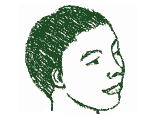|
Gen Y - Program and Curriculum Guide
Section II: Unit 5: Digital Media
- Analog and Digital Equipment
- Digital Graphics
- Digital Audio
- Digital Video
Unit 5 contains:
- Overview
- The Gen Y View
- Project ideas
- Terms to know
- 10 Infopages (handouts, quizzes, scripts, etc. on CD-ROM and online)
- Standards
- Activities with Prioritized Objectives
- 4 Lesson Plans - for one or more classroom periods. Each with:
- Materials
- Pre-lesson checklist
- Background information
- Procedures
- Assessment (print and online)
- Activity extensions
- Related issues
- Teacher Toolkit
- Alternate activities if hardware is not working
Evaluate the full curriculum guide. Click
here for details.
Sample Sections
Unit 5: Digital Media Overview
"Einstein admitted that he did not think in words, but visual images.
His early formulations for the theory of relativity came in images of
himself riding a light wave. Only later did he come to words."
�Judith Fueyo, "Language Arts Classrooms: Spaces Where
Anything Can Happen," Writing Teacher, September 1991
The arrival of inexpensive digital technologies, such as digital still
and video cameras, scanners, CD, DVD, and other high-capacity digital
storage systems, has rapidly accelerated the conversion of analog images
to digital format. This conversion, in turn, has been largely responsible
for the explosive growth of computer-based multimedia as a form of both
educational and artistic expression.
Our students interpret their worlds and represent their learning with
more than words. Digital technology makes up the Language Arts of today;
it invites and encourages teachers and students to include graphics, sound,
and movies in their teaching and learning. Literacy must include many
new skills and address the different types of "reading and writing" required
of our students. Printers of today include computer monitors, VCRs, SmartBoards,
and many other technologies. Digital expertise is an essential skill for
the information age.
This unit introduces Generation Y students to digital media tools and
software that enable them to create and manipulate graphics, audio, and
video files. The ability to successfully capture and use digital media
files will substantially contribute to the efficacy and quality of Generation
www.Y projects.
Activities & Prioritized Objectives
Following the completion of Unit 5, students will be able to:
| Activity 1�Analog and Digital Equipment |
| |
1.1 |
Understand the difference between digital and analog |
| |
1.2 |
Identify digital and analog technology available in
the school |
| |
1.3 |
Access Web-based resources for information on equipment
and graphic-design resources |
| |
|
|
| Activity 2�Digital Graphics |
| |
2.1 |
Learn how to use resources (equipment will vary):
 digital
still camera digital
still camera
 scanner scanner
 laser
discs and player laser
discs and player
 visual
presenter (light table) visual
presenter (light table)
 draw
and paint programs draw
and paint programs
 Web-based
collections or libraries Web-based
collections or libraries |
| |
2.2 |
Follow basic photography guidelines |
| |
2.3 |
Use resolution guidelines |
| |
2.4 |
Compile a personal library of digital files using available
resources |
| |
2.5 |
Employ software to download, edit, produce, and manipulate
digital files |
| |
2.6 |
Identify and use different file formats |
| |
|
|
| Activity 3�Digital Audio |
| |
3.1 |
Learn how to use resources (equipment will vary):
audio equipment (Music CDs, sound libraries, microphones) |
| |
3.2 |
Compile a personal library of digital files using
available resources |
| |
3.3 |
Employ software to download, edit, create original
graphics, and manipulate digital files |
| |
3.4 |
Identify and use different file formats |
| |
|
|
| Activity 4�Digital Video |
| |
4.1 |
Learn how to use resources (equipment will vary): video
cameras (analog and digital) |
| |
4.2 |
Follow basic guidelines for producing video |
| |
4.3 |
Compile a personal library of digital video files using
available resources |
| |
4.4 |
Employ software to download, edit, produce, and manipulate
movie files |
| |
4.5 |
Identify and use different file formats |
Next: Unit 6: Reasearching on the Web
Unit 1 | Unit
2 | Unit 3 | Unit
4 | Unit 5 | Unit
6 | Unit 7 | Unit
8 | Unit 9 | Unit
10
|

